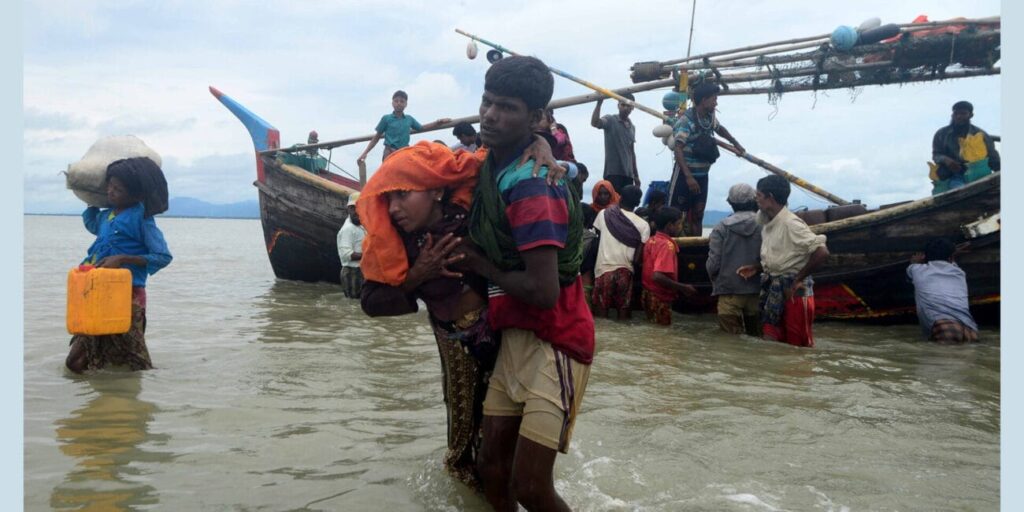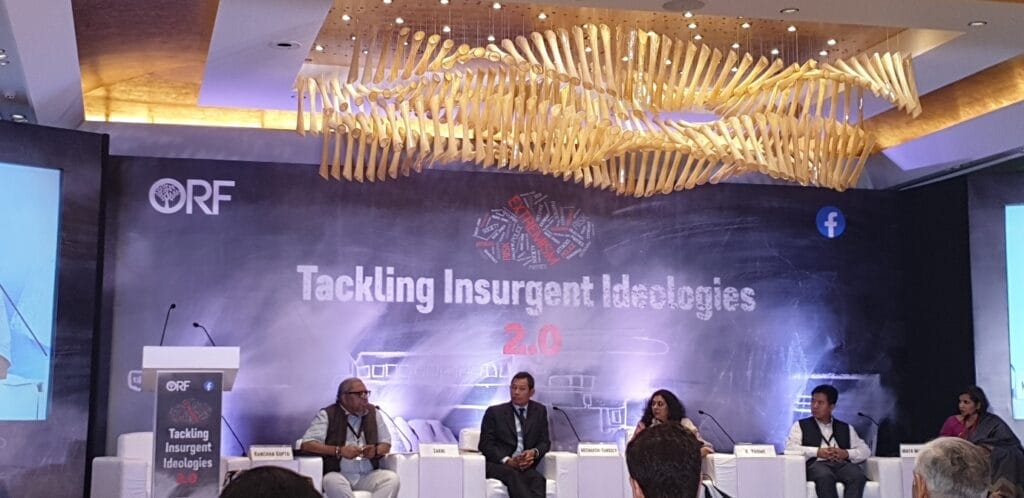Hindutva India Deporting Rohingya Refugees by Throwing Them into the Andaman Sea
TRANSCEND MEMBERS, 26 May 2025
Maung Zarni | FORSEA – TRANSCEND Media Service

Rohingya refugees cross into the mainland after arriving in Bangladesh.
Photo: Mamunur Rashid / Shutterstock.com
19 May 2025 – On 17 May, The New York Times reports that “(t)he United Nations has called for an investigation into “credible reports” that Indian authorities rounded up Rohingya refugees and expelled them, in some cases by putting them into the Andaman Sea off the shore of the same country they had escaped from, fearing persecution and death.”
Prime Minister Narendra Modi’s India is in the global headlines for one wrong reason or another while its close strategic partner, the Israel of Prime Minister Netanyahu, is reportedly starving Gaza’s 2.3 million besieged Palestinians to death.
On 17 May, The New York Times reports that “(t)he United Nations has called for an investigation into “credible reports” that Indian authorities rounded up Rohingya refugees and expelled them, in some cases by putting them into the Andaman Sea off the shore of the same country they had escaped from, fearing persecution and death.”
A day earlier on 16 May, India’s highly reputable media outlet WIRE.IN quoted a sister of one of the 38 victims of India’s latest act of cruelty, as saying “My brother came to India after our village was burned. He walked for days with wounds on his legs and buried our parents on the way. He was just trying to survive. When the police came, they said it was only for biometrics. He trusted them and went. That was the last time we saw him,” said Amina, days after her brother, among a group of 38 Rohingya refugees, was reportedly thrown into international waters by Indian officials.
The deeply troubling, reported incident of the Indian navy “dumping a group of 38 Rohingya refugees into the Bay of Bengal followed by the significant ruling by the country’s Supreme Court, a week or so early on 9 May, that Rohingyas don’t have the right to reside on India soil. The 3-judges of the court accepted the executive branch’s (the Modi government’s) argument that Rohingyas in India in general and (the India-occupied) Jammu and Kashmir in particular are India’s national security concern.
Colin Gonsalves, the Indian senior advocate who has petitioned the Supreme Court for the stay on deportation, had poked holes in the baseless argument that Rohingyas have “terrorist links”. In his words, “In Jammu, the government claimed that they were deporting the Rohingya because of terrorist links, but we all know that was not the case. They are being deported because they are Muslim. That is the only answer that remains. They are not terrorists. They don’t have criminal cases against them. So the government must ask itself: Why are we deporting them?”
India is home to less than 20,000 Rohingya who fled Myanmar’s slow-burning genocide that has been institutionalized by the country’s anti-Muslim military since the late 1970’s, although the world has taken notice of them when the livestreamed images of 740,000 Rohingya men, women, elderly and children fleeing on foot into the Bangladesh in the fall of 2017 began to flood the social media feeds.

Rohingya refugees entering Bangladesh after being driven out of Rakhine State, 2017. Wikipedia Commons
Modi government’s argument that estimated 20,000 Rohingyas in India are a threat to India’s national security is not a serious argument backed by any evidence or empirical credibility.
Based on my own private conversations with Rohingyas in India during my visits to the country, and subsequently, since 2018, many of the Rohingyas are registered with the United Nations High Commission for Refugees in India, the sole UN technical agency with the protection mandate. A large percentage of them lead precarious hand-to-mouth existence, with many families living in very hazardous conditions such as living near the sites of urban garbage dumps in places like New Delhi. Some of the young Rohingya community leaders receive support from sympathetic local Indians who provide them with leadership training, intellectual support, political protection, some financial support to make the best out of their dire life conditions. Constantly fearful of arbitrary arrests, indefinite detention, threats to their meagre livelihood and frightening interrogation, Rohingyas are among the most law-abiding individuals in India.
For Modi government framing such a tiny, vulnerable community of Myanmar genocide survivors on the Indian soil as “a national security threat” to one of the two most populous nations on earth – with 1.4 billion people – whose economy is ranked 5th in the world, with one of the most technologically advanced national armed enforces, presiding over a vast global web of police, intelligence and assassin networks worldwide has only one purpose: to fan the ruling BJP party’s official Islamophobia.
This is straight from the playbook of the Nazi propagandists who demonized “the Jude”, whose (alleged) crimes the Third Reich maintained in a separate “crime registry” based solely on the Jewish identity of any alleged criminal.
It bears pointing out that the highly respected refugee rights advocates such as Colin Gonsalves have effectively countered the Indian government’s deliberately false demonization of Rohingyas as “a security threat” to India. The three judges of the highest bench in India have not only embraced this bogus “security threat” but they have even questioned Rohingyas’ first-person accounts of how Indian authorities (including the New Delhi police and the Indian national navy) deceived, kidnapped, shipped and dumped them in the Andaman Sea.
The head of India’s ruling party BJP, with its Hindutva (read the Hindu equivalent of Fascist sentiments), Amit Shah, also the Union Home Affairs Minister, has framed Bangladeshi and other migrants and asylum-seekers such as Rohingya as “termites” as early as 2018.
During my first visit to New Delhi, India in August 2019, I heard the echoes of Amit Shah’s Nazi-esque dehumanizing rhetoric against the vulnerable refugees and migrants from BJP supporters. One senior Indian journalist, named Kanchan Gupta, with strong BJP sympathies who was with me on a roundtable discussion at the Facebook-funded, Observer Research Foundation(ORF)-hosted conference on “insurgent ideologies” launched an Islamophobic tirade against the Rohingya Muslim terrorists in Myanmar who allegedly murdered 100 local Hindus in Myanmar’s Western state of Rakhine.

Kanchan Gupta, distinguished fellow with the ORF, promoting the Hindutva view of Rohingya Muslims in Myanmar, New Delhi, 9 August 2019 (photo by an ORF friend)
Even if the allegations were credible and factual – which many of us seasoned researchers on the subject of Rohingya persecution have serious questions – it was very clear to me that my Hindutva co-panelist who is a distinguished fellow at the host ORF had a far greater sympathy for the 100 murdered Hindus in Myanmar than many thousands genocidally slaughtered in the killing fields of Western Myanmar and the one million Rohingyas who fled Buddhist Myanmar’s textbook genocide in 2016 and 2017, and found themselves in sub-human conditions in the refugee camps in Cox’s Bazaar in the neighbouring Bangladesh.
In her research article, Hindutva Politics and the Making of Extreme Precarity Monika, Verma, of National Yang Ming Chiao Tung University Institute of Social Research and Cultural Studies of Taiwan, has made a rather acute observation about the Hindutva state in India. She writes, “the BJP’s stance of hostility toward the Rohingyas can be viewed as a manifestation of Hindutva’s inherent anti-Muslim character. Additionally, it will posit that this antagonistic approach serves as a strategic maneuver by the BJP to consolidate its vote bank, thereby solidifying the connection between political ideology and refugee policies.”

Unlike its strategic and business partners, namely Jewish Supremacist Israel and Buddhist Nationalist Myanmar, India of Hindutva Fascist regime may not have perpetrated the genocide against its own Muslims – the world’s largest concentration of Muslims is in India – or may not have mass-deported a few million Muslims in Assam, despite New Delhi’s threats. But its cruel act of dumping 38-Rohingya men, women, children and elderly into the Andaman Sea should be treated as a warning of things to come, beyond the ruling BJP’s electoral strategy. For genocidal rhetorics inevitably prime ethnic and religious majoritarian societies for textbook genocides and ethnic cleansing.
In the two YouTube-lived events in Karachi and Islamabad, I shared my grounded thoughts on genocides as a large-scale crime of group destruction jointly perpetrated by various state organs (all 3 branches of state power) and the dominant civil society, beyond the intellectually inadequate, if mainstreamed the Convention on the Prevention and Punishment of the Crime of Genocide (or the Genocide Convention).
This binding inter-state treaty adopted on 9 December 1948 has proven itself an impotent legal instrument which has failed to either prevent any genocidal acts or processes or hold to account state party (signatory) for its genocidal crimes anywhere in the world. Watch below: Professor Penny Green, the founding Director of the International State Crime Initiative at Queen Mary University of London Law Department make a brilliant argument against the illusion of international law as the protector of the persecuted populations, in particular, Palestinians under Israel’s settler colonization of Palestine.
___________________________________________
 A Buddhist humanist from Burma (Myanmar), Maung Zarni, nominated for the 2024 Nobel Peace Prize, is a member of the TRANSCEND Network for Peace Development Environment, former Visiting Lecturer with Harvard Medical School, specializing in racism and violence in Burma and Sri Lanka, and Non-resident Scholar in Genocide Studies with Documentation Center – Cambodia. Zarni is the co-founder of FORSEA, a grass-roots organization of Southeast Asian human rights defenders, coordinator for Strategic Affairs for Free Rohingya Coalition, and an adviser to the European Centre for the Study of Extremism, Cambridge. Zarni holds a PhD (U Wisconsin at Madison) and a MA (U California), and has held various teaching, research and visiting fellowships at the universities in Asia, Europe and USA including Oxford, LSE, UCL Institute of Education, National-Louis, Malaya, and Brunei. He is the recipient of the “Cultivation of Harmony” award from the Parliament of the World’s Religions (2015). His analyses have appeared in leading newspapers including the New York Times, The Guardian and the Times. Among his academic publications on Rohingya genocide are The Slow-Burning Genocide of Myanmar’s Rohingyas (Pacific Rim Law and Policy Journal), An Evolution of Rohingya Persecution in Myanmar: From Strategic Embrace to Genocide, (Middle East Institute, American University), and Myanmar’s State-directed Persecution of Rohingyas and Other Muslims (Brown World Affairs Journal). He co-authored, with Natalie Brinham, Essays on Myanmar Genocide.
A Buddhist humanist from Burma (Myanmar), Maung Zarni, nominated for the 2024 Nobel Peace Prize, is a member of the TRANSCEND Network for Peace Development Environment, former Visiting Lecturer with Harvard Medical School, specializing in racism and violence in Burma and Sri Lanka, and Non-resident Scholar in Genocide Studies with Documentation Center – Cambodia. Zarni is the co-founder of FORSEA, a grass-roots organization of Southeast Asian human rights defenders, coordinator for Strategic Affairs for Free Rohingya Coalition, and an adviser to the European Centre for the Study of Extremism, Cambridge. Zarni holds a PhD (U Wisconsin at Madison) and a MA (U California), and has held various teaching, research and visiting fellowships at the universities in Asia, Europe and USA including Oxford, LSE, UCL Institute of Education, National-Louis, Malaya, and Brunei. He is the recipient of the “Cultivation of Harmony” award from the Parliament of the World’s Religions (2015). His analyses have appeared in leading newspapers including the New York Times, The Guardian and the Times. Among his academic publications on Rohingya genocide are The Slow-Burning Genocide of Myanmar’s Rohingyas (Pacific Rim Law and Policy Journal), An Evolution of Rohingya Persecution in Myanmar: From Strategic Embrace to Genocide, (Middle East Institute, American University), and Myanmar’s State-directed Persecution of Rohingyas and Other Muslims (Brown World Affairs Journal). He co-authored, with Natalie Brinham, Essays on Myanmar Genocide.
Tags: Burma/Myanmar, Civil War, Ethnic Cleansing, Genocide, Human Rights, India, Massacre, Migrants, Narendra Modi, Refugees, Rohingya
DISCLAIMER: The statements, views and opinions expressed in pieces republished here are solely those of the authors and do not necessarily represent those of TMS. In accordance with title 17 U.S.C. section 107, this material is distributed without profit to those who have expressed a prior interest in receiving the included information for research and educational purposes. TMS has no affiliation whatsoever with the originator of this article nor is TMS endorsed or sponsored by the originator. “GO TO ORIGINAL” links are provided as a convenience to our readers and allow for verification of authenticity. However, as originating pages are often updated by their originating host sites, the versions posted may not match the versions our readers view when clicking the “GO TO ORIGINAL” links. This site contains copyrighted material the use of which has not always been specifically authorized by the copyright owner. We are making such material available in our efforts to advance understanding of environmental, political, human rights, economic, democracy, scientific, and social justice issues, etc. We believe this constitutes a ‘fair use’ of any such copyrighted material as provided for in section 107 of the US Copyright Law. In accordance with Title 17 U.S.C. Section 107, the material on this site is distributed without profit to those who have expressed a prior interest in receiving the included information for research and educational purposes. For more information go to: http://www.law.cornell.edu/uscode/17/107.shtml. If you wish to use copyrighted material from this site for purposes of your own that go beyond ‘fair use’, you must obtain permission from the copyright owner.
Join the discussion!
We welcome debate and dissent, but personal — ad hominem — attacks (on authors, other users or any individual), abuse and defamatory language will not be tolerated. Nor will we tolerate attempts to deliberately disrupt discussions. We aim to maintain an inviting space to focus on intelligent interactions and debates.